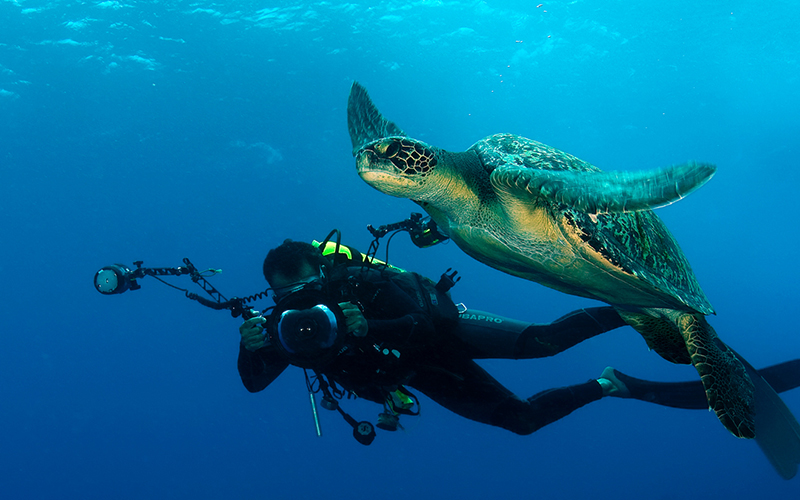The reserve is vital in ensuring the protection of the marine habitat and therefore marine life that make the islands such a valued holiday destination.
Everything about the Galapagos Islands is unique, and that is exactly why they need protecting. The volcanic formation, isolated position and varied currents create habitat unparalleled anywhere in the world.
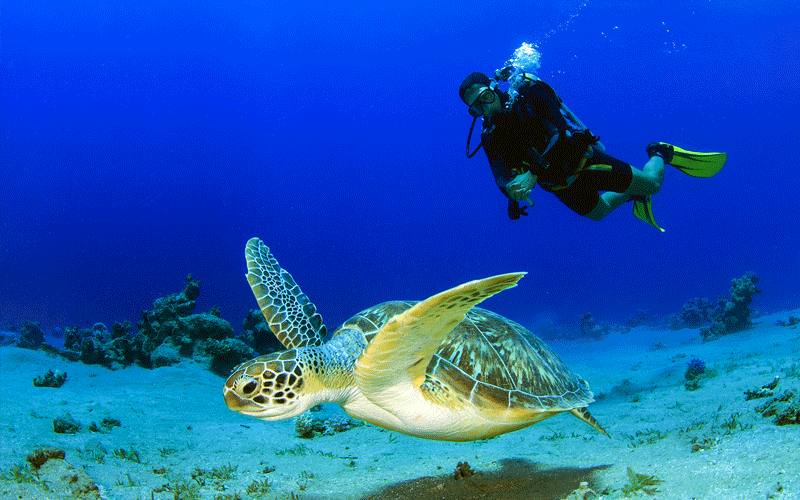
Although humans have the temptation to take advantage of these incredible resources, the marine reserve limits human activity to reduce the environmental footprint on the Galapagos Islands.
Described as a “living laboratory”, the marine reserve is home and feeding ground to an estimated 3000 diverse species of fish, whales, sharks, tortoises, turtles, birds and seals to name but a few.
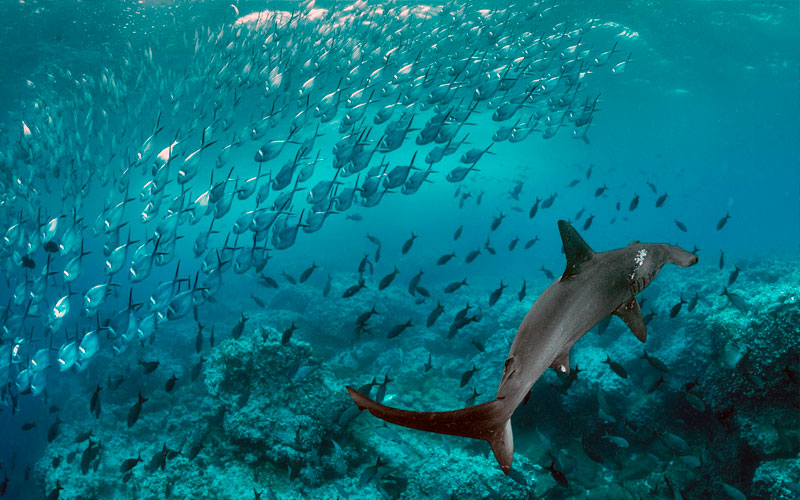
The incredibly tame nature of the wildlife, which allows visitors to approach, dive and play with the wildlife in their natural habitat is an advantage of the protection of this marine area.
On the 14th anniversary of the creation of the Marine Reserve as a protected area, Galapagos Travel Center want to thank the Reserve for their hard work.
The experts at Galapagos Travel Center invite you to book your trip to the clear waters and treasured wildlife that make your holiday truly unforgettable!

Galapagos Marine Life
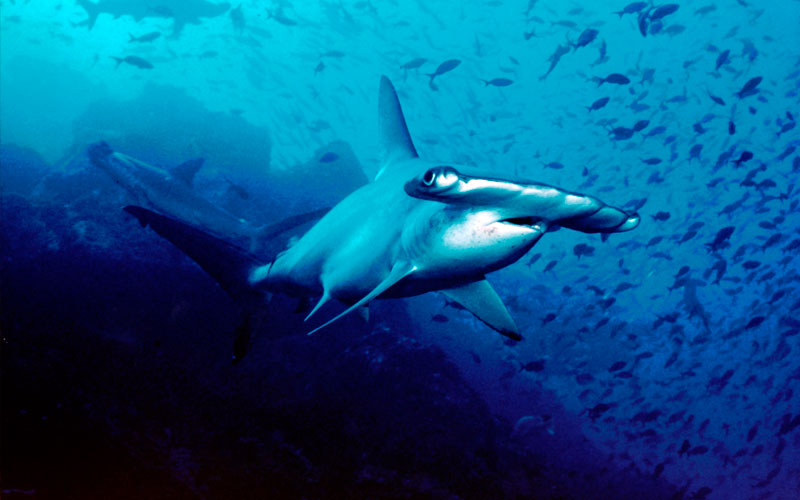
Beneath the waters of the Galapagos Islands is a fascinating world of underwater marvels. The convergence of ocean currents from distant corners of the world have brought an extremely unique variety of marine life to the Galapagos Islands. Such diversity and the pristine qualities of the waters surrounding the islands make the Galapagos an unforgettable destination.
Follow: GalapagosIslands.com
The ocean waters surrounding the islands are protected as the second largest marine reserve in the world. Snorkelers and divers in the islands never cease to be amazed by the wonders below the sea found no place other than the Galapagos Islands. From the coral reefs to the mangrove lagoons, the Galapagos waters are teeming with marine creatures.
Such diversity in the islands’ waters is sustained by the nutrient rich content carried to the islands by the cold water ocean currents. These same cold currents from the south brought Antarctic species like the fur sea lions and penguins to the tropical archipelago increasing the uniqueness of biodiversity displayed in the Galapagos.
Many varieties of marine species are well represented in the Galapagos. The assortment of colorful fish includes different types of sharks including whale sharks (which are the largest fish on the planet) and hammerheads, manta rays, angelfish, butterflyfish, surgeonfish, and seahorses.
Also dwelling in the ocean depths are so many species of corals, sponges, sea stars, sea cucumbers, clams, octopuses, sea slugs, worms, and crustaceans. Visitors often see bright red-colored Sally Lightfoot crabs on the beaches. Galapagos green sea turtles are beautiful and serene marine reptiles commonly seen in the islands as well.
When you visit the Galapagos Islands, you will be sure to discover an underwater world as colorful and unique as you could have ever imagined. Divers can take a designated diving cruise to the remote parts of the archipelago like Darwin and Wolf Islands where they can encounter the peaceful giant whale sharks in person!
Plan your Galapagos holiday today, and bring your underwater fantasies to life. Snorkel and swim in the company of multicolored tropical fish. Explore the rich coral reef ecosystems, and splash in the waves with penguins and sea lions. Our trip advisors will help you book your dream vacation in the islands, and you can experience the one of a kind underwater marine life for yourself.
Galapagos Marine Life endangered
Did you know about the huge size of the Galapagos Marine Reserve? Its total area is of 133,000 sq. km., which is almost the size of Louisiana. In the other hand, the islands that comprise the Galapagos National Park cover just a small area of 8,000 sq. km. of wonders and uniqueness. Therefore, most of the Galapagos preserved area is a comprised by a submarine word filled with amazing species, coral reefs and many more that you can only imagine, that’s why the Galapagos is considered one of the best diving destinations in the whole wide World.
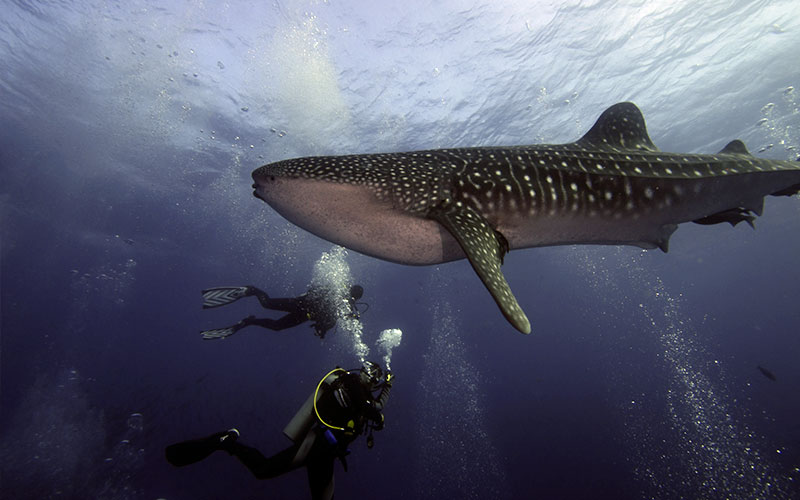
Because of the shallow sandy beaches, rocky shores, mangrove forests, lagoons, high vertical cliffs and coral reefs, the Galapagos is like a dream come true to every sea animal. Sea lions and fur seals can enjoy, play and sleep on the sandy beaches, crabs can run above the lava rocks while iguanas take advantage of the rock’s heat, as well as coral reefs which are a great playground and haven for small tropical fishes.
Due to these ideal conditions, the Galapagos waters are home to some of the most fantastic submarine species in the World, from seahorses, temporal visitors like the marine iguana, the Galapagos penguin, to huge whale sharks, humpback and orcas whales. Playful sea lions will surround you while you go snorkeling, orcas may get really close to the dinghy ride for a great picture, while dolphins swim by the side of the boat during your cruising.

However, many of those amazing animals are threatened. Sharks, lobsters and sea cucumbers for example, are being killed because of overfishing. Luckily, many organizations as well as local fishermen are trying to reduce the fishing of these species. However there is also illegal fishing which is much harder to control. It’s unbelievable but some illegal fishermen hunt tortoises for their meet and sea lions for their teeth and genitals. As weird as it may seem sea lions genitals are considered as aphrodisiac in Asia. Also, the meat, fins and oil of whale sharks as well as the fins of all other kinds of sharks are quite popular on the international markets – e.g. For shark fin soup – which in many places is considered a delight.
Why do so many sharks have to be killed or die by the consequences of having their fins cut off? How can someone just cut out teeth and genitals of poor cute sea lions? Right? This has to stop!! Fortunately, the sea around Galapagos can be controlled by modern techniques and therefore unauthorized boats can be detected. But this sadly doesn’t mean that the illegal fishing can be completely prevented yet. Moreover, even the few legal fishing boats endanger many marine animals not just by overfishing, but also, penguins, sea lions and turtles often experience being bycatch. They get hurt, strangled by the net or drown in this procedure because they can’t get to the surface to get the needed air.
Another threat to the Galapagos marine life comes along with worldwide phenomenon’s, like garbage in the oceans, which makes water more acid, and to make the problem even worst, the climate change which is affecting the whole World heats up the waters arousing the water inhabitants.
10 Million tons of garbage flow into our oceans every year. About 75% of it is plastic, which is fatal to many submarine species. Each year, up to 100.000 marine animals and about one million seabirds die due to plastic. To visualize this, we have some examples for you:
| Get in touch with one of our experts or request a callback they will be glad to assist you to watch the Galapagos undersea environment that holds quite a few endemic species, which means that you won’t be able to see them anywhere else in the World. |
When old fisher nets float on the ocean, dolphins, sea lions, turtles and other fish can easily get tangled in those. They either drown because they can’t get the air they need or suffer from severe injuries resulting from the attempt to disentangle. Many marine animals as well as sea birds die due to hunger even though their stomach is full, unfortunately, is full of plastic, which obviously is not their natural diet and therefore cannot be digested. Doesn’t have to be mentioned eating a lighter can cause some inner injuries. As it also does to humans, even a smaller consumption of plastic provokes infertility as well as changes in hormones and DNA in marine animals.
Did you know it can take up to 450 years for a plastic bottle to break down?
If this wasn’t enough, about half of the man-made billions of tons of CO2 emissions is absorbed by the ocean time after time. These emissions are turned into carbonic acid, which has devastating effects on the marine ecosystem. For some fish, the acidifications causes reproductive disorders, so that they die out slowly. Moreover gravely affected are shell-forming animals such as corals, oysters, shrimps and lobsters, who have trouble building up their shells in more acid waters. And through this, of course all those Galapagos animals who feed on them, like many sea birds.
Let’s talk a bit about the corals – the acidification as well as the warming ocean temperature threaten them a lot, at it shows at first sight!, many corals are already bleached, which means more than close to dead. This is not just sad for humans to watch, but a huge threat to about 25% of all the marine species, who rely on corals for food and shelter. This means that with more and more bleached corals, less beautiful fish will be there to watch. So the amazing and colorful adventure of snorkeling and diving in the Galapagos might not be that beautiful anymore if we continue treating our earth and oceans as we do now. Actually, diving and snorkeling in Galapagos before the El Niño Event in 1982 must have been indescribable beautiful! During this event, 95% of the Galapagos coral bleached. It’s really a justified question why we humans still do so less about caring for our oceans. They are beautiful, giving us food supply and, well, a huge part of the oxygen in the Earth’s atmosphere. Something we should be concerned about.
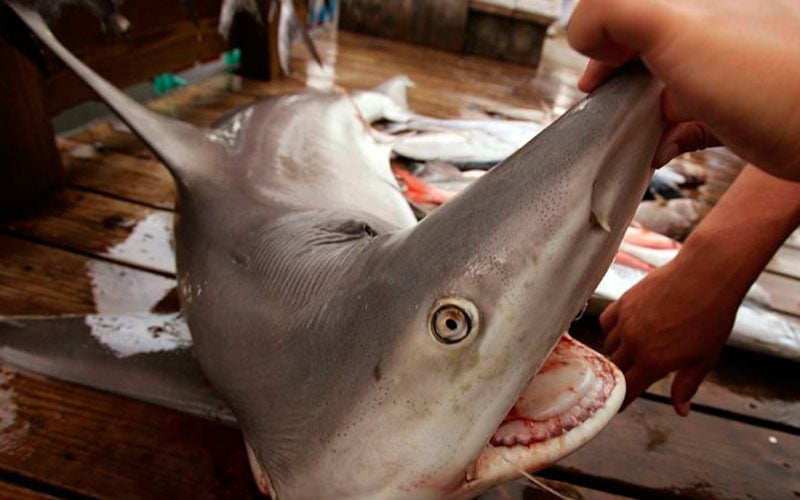
Last, but not least, climate change in general of course also plays a great role in threatening many of our beloved Galapagos animals. The cute penguin now profits from the cold currents that allow him to live in the Galapagos. But if the temperatures continue rising, even this current can’t do much for the penguin. As this specie cannot reproduce on high temperatures, the rising of the World temperature can produce the ending of this unique bird, yeap! Bye Bye Birdie. Some other species you might keep in mind are the sea turtles and marine iguanas. They lay their eggs on the shores. And it’s not just the introduced predators, which make life of the unborn hardly possible but also because of the rising sea levels due to the climate change. A higher sea level means less space on shore and consequently fewer eggs and less baby turtles and marine iguanas.
In order to preserve the beautiful Galapagos Marine Life as well as all those marine species all over the planet, we need to take action! We need to reduce our plastic consumption and we should get all our garbage out of the oceans as soon as possible – and don’t let any more garbage flow into it! Just take your favorite cotton bag instead of plastic ones next time you go shopping – and you already do a small step for saving our oceans. It’s a small drop into the ocean, but a way to get started. You can also join local beach-cleanups or donate to organizations engaging in saving oceans or fighting climate change consequences. Just don’t ignore it! It exists. Look at the corals. They don’t die cause it’s fun.
Our ocean is dying – and we are the only ones who can save it!
New Marine Sanctuary in the Galapagos Marine Reserve
The Galapagos Marine Reserve is the second largest marine reserve in the world and protects one of the planet’s most unique and most unusual marine ecosystems. With an area of 133,000 km2 (51,000 mi2) the Galapagos Marine Reserve is nearly half the size of the total land area of Ecuador.
Conservation efforts to protect this one-of-a-kind marine ecosystem began in 1986 with the purpose of protecting the waters surrounding the islands from overexploitation of resources. In 1998 the protected area was greatly expanded and formally came to be known as the Galapagos Marine Reserve. In 2001 the reserve achieved its status as a UNESCO World Heritage Site.
This month, Ecuadorian President Rafael Correa has announced the creation of a new marine sanctuary within the Galapagos Marine Reserve. This new sanctuary sets aside vast areas of the marine reserve as a sanctuary for the underwater ecosystems. All fishing and extraction of any natural resources are explicitly banned in the new marine sanctuary which covers 47,000 km2 (18,000 mi2) of the waters in the Galapagos Marine Reserve. Most of this area surrounds the northern islands of Darwin and Wolf which are world famous for their shark diversity. Other smaller areas surrounding the other islands have also been set aside as a marine sanctuary. These areas are now only open for scientific and tourism purposes.
The volcanic archipelago is world famous for its endemic animals on land, but the ocean ecosystem in the waters around the islands is just as fascinatingly rich and biodiverse. The islands rose out of the ocean millions of years ago due to volcanic activity and were colonized by a wide range of plants and animals carried to the region by the ocean currents. This equatorial archipelago is situated at the convergence of ocean currents from far and wide, and they brought with them the ancestors of the native creatures from such far flung places as Antarctica and California.
Native marine animals include more than 2900 species, 25% percent of which are endemic, meaning that they are found nowhere else on Earth. Among the most notable species are the Galapagos penguins (the only penguin species native to the Northern Hemisphere), Galapagos sea lions, Galapagos fur sea lions, dolphins, whales, hammerhead sharks, whale sharks, and blue-footed boobies. In addition to these well-known inhabitants, there are hundreds of species of colorful reef fish, corals, and other invertebrates, to mention a few.
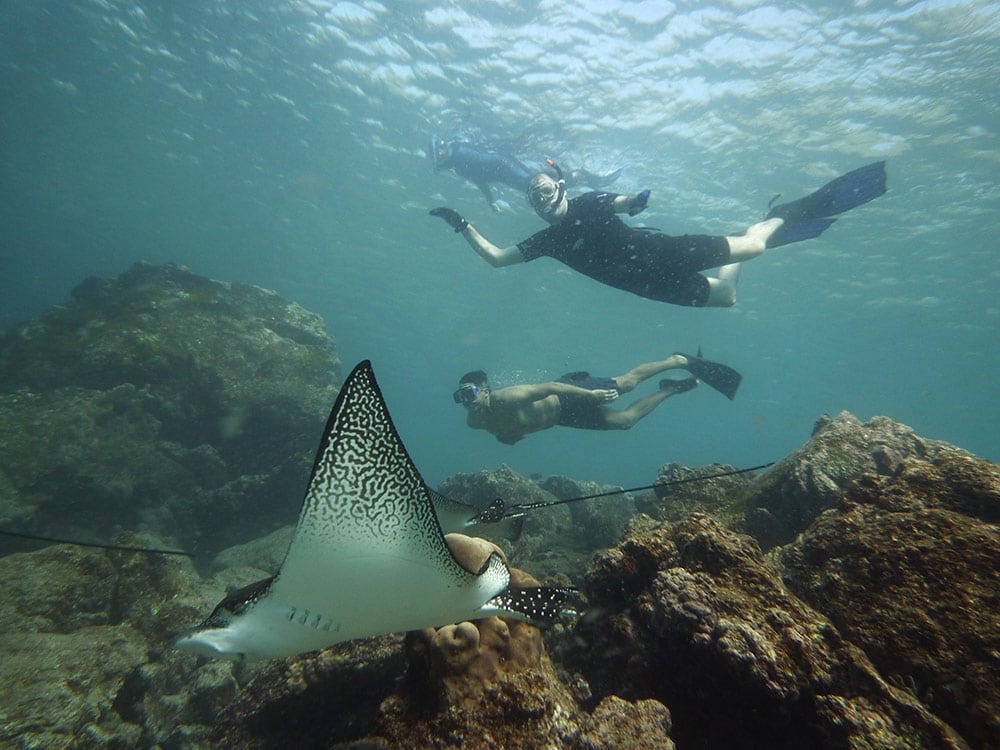
The conservation of this unique marine ecosystem is indispensable. In order to properly preserve the terrestrial habitats in the archipelago, the waters surrounding the islands must also be protected. The health of the animals on land is directly connected to their marine counterparts. The Galapagos Islands have often been considered a natural laboratory for discovering the mysterious of life, and this holds true for both the ecosystems on land as well as the marine ecosystem below the waves.
The undersea ecosystems surrounding the Galapagos Islands currently face several threats directly related to human activity in the archipelago. Among the most notable environmental threats include overfishing of sea cucumbers, shark finning, and the overharvesting of black coral. The Galapagos National Park and private conservation organizations are working very hard to stop these illegal activities and preserve the wonders of the Galapagos marine ecosystem for generations to come. The establishment of the new marine sanctuary is monumental because it ensures that the most vulnerable areas of the Galapagos waters are now fully protected for the first time in history.
When tourists visit the Galapagos Islands, they can snorkel and dive in the marine reserve at designated diving visitor sites. When visiting the Galapagos Islands, they can see in person the natural wonders of this unforgettable paradise on Earth. Those who visit the Islands return home as advocates for the preservation of the Galapagos Islands and the other last great places on the planet.
Book your trip to the Galapagos Islands today. Our expert trip advisors are standing by to get started on planning your holiday of a lifetime. Fulfill your dreams and swim with dolphins, whale sharks, and sea lions. Snorkel in the Galapagos waters and see the colorful fish and coral reefs flourishing in a marine sanctuary unlike any other in the world. From flights to hotel accommodations to cruise reservations, our trip advisors have you covered. Come to the islands and immerse yourself in the wonders of the Galapagos.

